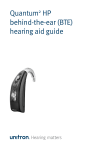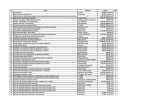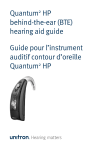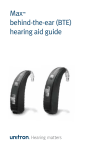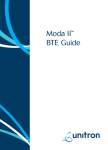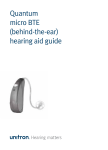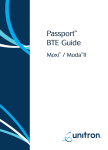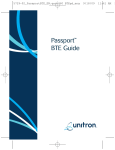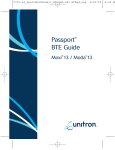Download Unitron Shine Rev User guide
Transcript
Shine Rev behind-the-ear (BTE) hearing aid guide ™ Thank you Thank you for choosing Unitron hearing aids. At Unitron, we care deeply about people with hearing loss. We work closely with hearing healthcare professionals to make advanced, purpose-driven solutions available to everyone. Because hearing matters. This user guide applies to the following models: Shine Rev S BTE Shine Rev HPm BTE Shine Rev HP BTE Your hearing aids Hearing healthcare professional:________________ ___________________________________________ Telephone:__________________________________ Model: _____________________________________ Serial number:_______________________________ Replacement batteries: Size 13 Size 675 Warranty:___________________________________ Program 1 is for: _____________________________ Program 2 is for: _____________________________ Program 3 is for: _____________________________ Program 4 is for: _____________________________ Date of purchase: ____________________________ Quick reference Table of contents Changing batteries Low battery warning Your hearing aids at a glance...................................................... 2 2 beeps every 30 minutes Warnings..................................................................................... 4 Putting your hearing aids on your ears.......................................8 Turning your hearing aids on and off ........................................ 10 Plus (+) signs Battery information.................................................................... 11 13 Tips for wearing hearing aids for the first time...........................14 675 On/Off Operating instructions.............................................................. 16 Using the telephone...................................................................19 Protecting your hearing aids.....................................................20 Cleaning your hearing aids.........................................................21 Assistive listening devices........................................................ 25 Troubleshooting guide.............................................................. 26 On Off Open Lever volume control; up=louder, down=softer Push button switching programs Warning to hearing aid dispensers (to comply with the U.S. Food and Drug Administration (FDA) regulations) .............................................31 Information and explanation of symbols.................................. 34 Patient feedback....................................................................... 36 Additional notes........................................................................ 37 Your hearing aids at a glance 1 Earhook - your custom made earmold attaches to your hearing aids using the earhook 2 Microphone - sound enters your hearing aids through the microphones. Microphone shield protects microphones from dirt & debris 3 Push button - switches between listening programs 2 3 6 4 5 2 4 Lever - controls the volume 3 5 Battery door (on & off) - close the door to turn on your hearing aids, partly open the door to turn off your hearing aids. Opening the door all the way gives you access to change the battery 4 6 Tubing - part of the earmold that attaches it to the earhook 7 E armold - allows the sound to pass from the hearing aids to the ear and holds the hearing aids in place 5 7 8 7 2 3 8 Power slim tube/slim tube - sound travels down the power slim tube or slim tube to the ear canal 4 9 D ome - holds the slim tube in place in the ear canal 5 2 1 8 9 3 Warnings The intended use of hearing aids is to amplify and transmit sound to the ears and hereby compensate for impaired hearing. The hearing aids (specially programmed for each hearing loss) must only be used by the intended person. They should not be used by any other person as they could damage hearing. Hearing aids should only be used as directed by your physician or hearing healthcare professional. Hearing aids will not restore normal hearing and will not prevent or improve a hearing impairment resulting from organic conditions. Do not use your hearing aids in explosion hazard areas. Allergic reactions to hearing aids are unlikely. However, if you experience itching, redness, soreness, inflammation or a burning sensation in or around your ears, inform 4 your hearing healthcare professional and contact your physician. In the unlikely case that any parts remain in the ear canal after the removal of the hearing aid, contact a physician immediately. Remove your hearing aids for CT and MRI scans or for other electromagnetic procedures. Special care should be exercised in wearing hearing aids when maximum sound pressure levels exceed 132 decibels. There may be a risk of impairing your remaining hearing. Speak with your hearing healthcare professional to ensure the maximum output of your hearing aids is suitable for your particular hearing loss. Battery warnings Never leave hearing aids or batteries where small children and pets can reach them. Never put hearing aids or batteries in your mouth. If a hearing aid or battery is swallowed, call a physician immediately. 5 Precautions The use of hearing aids is only part of hearing rehabilitation; auditory training and lip reading instruction may be required as well. In most cases, infrequent use of hearing aids does not provide full benefit. Once you have become accustomed to your hearing aids, wear your hearing aids everyday all day. Your hearing aids use the most modern components to provide the best possible sound quality in every listening situation. However, communication devices such as digital cell phones can create interference (a buzzing sound) in hearing aids. If you experience interference from a cell phone being used close by, you can minimize this interference in a number of ways. Switch your hearing aids to another program, turn your head in a different direction or locate the cell phone and move away from it. 6 This hearing aid is not designed to be used for children under 36 months. The hearing aid contains small parts that can cause choking if swallowed by children. Keep out of reach of pets, children and mentally challenged people. If swallowed, consult a physician or hospital immediately. External devices may only be connected if they have been tested in accordance with corresponding IECXXXXX standards. Only use accessories approved by Phonak AG, to avoid any electrical shock. Note to hearing healthcare professional Domes should never be fitted on patients with perforated eardrums, exposed middle ear cavities, or surgically altered ear canals. In the case of such a condition, we recommend to use a customized ear mold. Labeling The serial number and year of manufacture are located inside the battery door. 7 Putting your hearing aids on your ears 3.Place the hearing aid over the top of your ear. Your hearing aids may be color-coded with a small dot on the battery door: red = right ear; blue = left ear. Hearing aids with slim tubes Hearing aids with earmolds 1.Hold the earmold between 1. your thumb and index finger. The opening should be pointing in towards your ear canal with the hearing aid resting upwards above your ear. 2. 2.Carefully insert the earmold in your ear. You may need to twist it slightly to the back. The earmold should fit into your ear snugly and comfortably. Gently pull 3. down and back on your earlobe to help you insert the earmold into your ear canal more easily. 8 1.Place the hearing aid over 1. the top of your ear. The slim tube should lie flush against your head and not stick out. 2.Hold the slim tube where it attaches to the dome and 2. gently push the dome into your ear canal. 3.Place the retention piece in your ear so it rests at the bottom of the opening of 3. your ear canal. 9 Turning your hearing aids on and off Battery information Your hearing aids have a three-position battery door that acts as an on/off switch and that allows access to the battery compartment. 1. On: Close the battery door 1. fully. To replace the battery, fully open the battery door for access to the battery compartment. Note: It may take 5 seconds before the hearing aid turns on. Your hearing healthcare provider can increase the start up delay if required. 2. O ff: Partially open the battery door. 3. Open: Fully open the battery door to access and change the battery. 10 2. 3. Note: When turning your hearing aid on and off while it is on the ear, grasp the top and bottom of the hearing aid with your index finger and thumb. Use the index finger of your opposite hand to open and close the battery door. Low battery warning Two long beeps indicate the hearing aid battery is low. After the low battery warning, sounds may not be as clear. This is normal and can be fixed by changing the batteries in the hearing aids. If you are not able to hear the low battery warning, your hearing healthcare professional can change its pitch or loudness. If you prefer, it can be turned off entirely. Your hearing aids are designed to generate a low battery warning every 30 minutes until you change the batteries, but depending on the condition of the batteries, they may die before another low battery warning occurs. Therefore, it is recommended that the batteries are replaced as soon as possible once you hear the low battery warning. 11 Replacing the battery 1. 1.Gently swing out the battery door with your fingernail. 2.Grasp the battery with your thumb and index finger and 2. remove. 3.Insert the new battery into the battery compartment with the plus (+) sign on the battery facing the same way as the 3. plus (+) sign on the side of the battery door. This will ensure that the battery door closes properly. Note: If the battery is inserted incorrectly, the hearing aid will not turn on. Caring for batteries Always discard batteries in a safe and environmentally friendly way. To prolong battery life, remember to turn your hearing aids off when not in use, especially when asleep. Remove the batteries and keep the battery door open while hearing aids are not being worn, especially when asleep. This will allow internal moisture to evaporate. 4. 4. Close the battery door. Note: There is a tamper‑proof battery door option for these hearing aids. Please see your hearing healthcare professional for further information. 12 13 Tips for wearing hearing aids for the first time • Start in a quiet room at home first to get • • • • 14 used to the new sound quality. Sounds like the ticking of a clock, the humming of the computer, the beep of the microwave or the rustling of clothes or paper may seem loud to you at first, because you have not been hearing them properly for a long time. Read aloud to yourself and learn to adjust the volume of your own voice when you are wearing the hearing aids. Talk to different people and learn how to distinguish between different sound patterns again. It will take some time before you are completely used to your hearing aids and can fully enjoy the benefits. Wear your hearing aids for as many hours a day as you can, and for a little longer each day. • Make notes at the back of this booklet, write down difficult situations and describe what any unpleasant noises were like. This information will help your hearing healthcare professional to fine-tune the hearing aids better for your needs. • Involve your family and friends in this familiarization period. For example, ask someone to set the television to a comfortable volume. • When you are beginning to get used to wearing the hearing aids, wear them in more difficult listening environments such as the office, at parties or in restaurants. This can be difficult even for people who can hear normally. Give yourself time to regain your ability to hear in these difficult situations. • Make your hearing aids part of your everyday life and be patient with yourself while you are learning to hear sounds correctly. 15 Operating instructions Tamper-resistant cover Your hearing aids come with two controls that allow you to further adjust them – a lever and a push button. Lever - volume control • Press up to increase volume • Press down to decrease volume Some hearing aids are fitted with tamper-resistant covers instead of levers to prevent someone from accidentally adjusting the hearing aids. The cover can still be used to make adjustments but it requires using a fingernail or a small tool to push up or down. As you change the volume level, your hearing aids will beep. Volume setting Suggested volume level Beeps 1 beep Turning volume up short beep Turning volume down short beep Maximum volume level 2 beeps Minimum volume level 2 beeps 16 17 Push button - program control Your hearing aids are equipped with a push button which can be used to switch between programs. Each time you push the button, you will move to a new hearing aid program. Your hearing aids beep to indicate which program you are in. Program 1 (e.g. AutoMic) 1 beep Program 2 (e.g. speech in noise) 2 beeps Program 3 (e.g. telephone) 3 beeps Program 4 (e.g. music) 4 beeps Please see the front of this booklet for a listing of your personalized programs. 18 Using the telephone As telephones do not all work the same, you may experience different results from different phones. You can use many phones by simply holding the receiver to your ear, without the need to change to a dedicated telephone program on your hearing aid. You may need to move the handset slightly up or back to find the position that sounds best to you. Depending on the phone type you use, your hearing healthcare professional might have selected a dedicated phone program on your hearing aids. Your hearing healthcare professional may have set up a phone program that you can access through the push button on your hearing aids. 19 Protecting your hearing aids Cleaning your hearing aids • Open the battery door when not in use. Use a soft cloth to clean your hearing aid at the end of each day, and place it in its case with the battery door open to allow moisture to evaporate. • Always remove your hearing aids when • • • • • 20 using hair care products. The hearing aids can become clogged and cease to function properly. Do not wear your hearing aids in the bath or shower or immerse them in water. If your hearing aids do become wet, do not attempt to dry them in an oven or microwave. Do not adjust any controls. Open the battery doors immediately, and allow your hearing aids to dry naturally for 24 hours. Protect your hearing aids from excessive heat (hair dryer, vehicle glove box or dashboard). Regular use of a dehumidifier, such as a Dri-Aid kit, can help prevent corrosion and prolong the life of your hearing aids. Do not drop your hearing aids or knock them against hard surfaces. Ear wax is natural and common. Ensuring your hearing aids are free of ear wax is an important step in your daily cleaning and maintenance routine. Never use alcohol to clean your hearing aids, earmolds or domes. Do not use sharp tools to dislodge ear wax. Sticking household items into your hearing aids or earmolds can seriously damage them. Cleaning your earmolds Clean the earmold and the outside of the earhook with a damp cloth at the end of each day. Do not use alcohol to clean your earmolds. 21 If the earmolds become plugged, clear the opening with a wax loop or pipe cleaner. If your physician prescribes eardrops, clean any moisture that may get into the earmolds or tubing to prevent plugging. If the earmolds require further cleaning: 1.Disconnect the plastic tube from the hook of the hearing aid, by holding the hearing aid in one hand and gently pulling the tubing away from the earhook. 2.Wash only the earmolds and tubing in warm water with a mild soap. 3.Rinse them with cool water and dry overnight. 4.Make sure the earmold tubes are completely dry. Reconnect them to the earhook on your hearing aid by sliding the tubing back on to the earhook. Use of a hearing aid blower can assist with removing moisture/debris from the tube. See your hearing healthcare professional for more information. 22 Cleaning your slim tubes and domes You should have the slim tubes and domes replaced by your hearing healthcare professional approximately every three to six months or when they become stiff, brittle, or discolored. Clean the outside of the domes at the end of each day with a damp cloth. You should also clean the slim tubes periodically, with the cleaning pin provided, when you begin to notice debris in and around the tubes. 1. Hold the slim tube in one hand and the hearing aid in the other hand. 2. Gently turn the hearing aid until it detaches from the slim tube. 3. Use a damp cloth to clean the outside of the slim tube and dome. 4. Remove the dome from the slim tube by pulling gently, before cleaning the slim tube. 23 5. Using the black cleaning pin provided in the kit, gently insert the cleaning pin where the slim tube attaches to the hearing aid and push the pin all the way through the tube. Note: The slim tubes and domes should never be rinsed or submerged in water as water drops may become lodged in the tube, block sound or damage the electrical components of the hearing aid. 6. Once the slim tube has been cleaned, reattach it by gently turning the hearing aid onto the slim tube. 7.Reattach the dome to the slim tube by gently pushing it back onto the threading at the end of the tube. You will feel the dome click onto the ridges of the slim tube, and you won’t be able to push it any further. 24 Assistive listening devices Listening in public places Your hearing aid may feature a telecoil to pick up electromagnetic energy and convert it into sound. Your hearing aid’s telecoil option can help you listen in public places equipped with telecoil compatible assistive listening devices such as a loop system. When you see this symbol, it means that there is a loop system installed; this loop system is compatible with your hearing aid. Please contact your hearing healthcare professional for more information on loop systems. Connecting to external audio sources Your hearing aids may feature an optional direct audio input (DAI) to connect to other audio sources, such as a stereo or television, using an FM system or a cable. Ask your hearing healthcare professional for information about the direct audio input system and a connector cord. 25 Troubleshooting guide Cause Possible remedy No sound Not turned on Replace battery Poor battery contact Consult your hearing healthcare professional Battery upside down Insert battery plus (+) side up Earmolds/slim tubes/ domes blocked with ear wax Clean earmolds/ domes. See “Cleaning your hearing aids.” Use cleaning pin to dislodge ear wax in slim tubes. Consult your hearing healthcare professional 26 Consult your hearing healthcare professional Possible remedy Not loud enough Low volume Turn up volume; see hearing healthcare professional for models without a manual volume control or if problem persists Low battery Replace battery Earmolds/slim tubes/ domes not inserted properly See “Putting your hearing aids on your ears.” Remove and reinsert carefully Change in hearing Consult your hearing healthcare professional Earmolds/slim tubes/ domes blocked with ear wax Clean earmolds. See “Cleaning your hearing aids.” Use cleaning pin to dislodge ear wax in slim tubes. Consult your hearing healthcare professional Plugged microphone shield Consult your hearing healthcare professional Turn on Low/dead battery Plugged microphone shield Cause 27 Cause Possible remedy Possible remedy Not clear, distorted Intermittent Low battery Replace battery Dirty battery contact Consult your hearing healthcare professional Two long beeps Low battery Cause Poorly fitting earmolds/ slim tubes/domes Consult your hearing healthcare professional Earmolds/slim tubes/ domes blocked with ear wax Clean earmolds. See “Cleaning your hearing aids.” Use cleaning pin to dislodge ear wax in slim tubes. Consult your hearing healthcare professional Low battery Replace battery Consult your hearing healthcare professional Replace battery Whistling Earmolds/slim tubes/ domes not inserted properly See “Putting your hearing aids on your ears.” Remove and reinsert carefully Plugged microphone shield Hand/clothing near ear Move hand/clothing away from your ear Earmolds/slim tubes/domes falling out of ear Poorly fitting earmolds/ slim tubes/domes Consult your hearing healthcare professional 28 Poorly fitting earmolds/ slim tubes/domes Consult your hearing healthcare professional Earmolds/slim tubes/ domes not inserted properly See “Putting your hearing aids on your ears.” Remove and reinsert carefully 29 Cause Possible remedy Weak on the telephone Telephone not positioned properly Move telephone receiver around ear for clearer signal. See “Using the telephone” Hearing aid requires adjustment Consult your hearing healthcare professional For any problems not listed in the guide or for service assistance, contact your hearing healthcare professional. Warning to hearing aid dispensers (to comply with the U.S. Food and Drug Administration (FDA) regulations) A hearing aid dispenser should advise a prospective hearing aid user to consult promptly with a licensed physician (preferably an ear specialist) before dispensing a hearing aid if the hearing aid dispenser determines through inquiry, actual observation, or review of any other available information concerning the prospective user, that the prospective user has any of the following conditions: (i) Visible congenital or traumatic deformity of the ear. (ii) History of active drainage from the ear within the previous 90 days. (iii) History of sudden or rapidly progressive hearing loss within the previous 90 days. (iv) Acute or chronic dizziness. (v) Unilateral hearing loss of sudden or recent onset within the previous 90 days. (vi) Audiometric air-bone gap equal to or greater than 15 decibels at 500 hertz (Hz), 1,000 Hz, and 2,000 Hz. (vii) Visible evidence of significant cerumen accumulation or a foreign body in the ear canal. (viii) Pain or discomfort in the ear. Special care should be exercised in selecting and fitting a hearing aid whose maximum sound pressure level exceeds 132 decibels because there may be risk of impairing the remaining hearing of the hearing aid user. [This provision is required only for those hearing aids with a maximum sound pressure capability greater than 132 decibels (dB).] Important notice for prospective hearing aid users Good health practice requires that a person with a hearing loss have a medical evaluation by a licensed physician (preferably a physician who specializes in diseases of the ear) before purchasing a hearing aid. 30 31 Licensed physicians who specialize in diseases of the ear are often referred to as otolaryngologists, otologists or otorhinolaryngologists. The purpose of medical evaluation is to assure that all medically treatable conditions that may affect hearing are identified and treated before the hearing aid is purchased. Following the medical evaluation, the physician will give you a written statement that states that your hearing loss has been medically evaluated and that you may be considered a candidate for a hearing aid. The physician will refer you to an audiologist or a hearing aid dispenser, as appropriate, for a hearing aid evaluation. The audiologist or hearing aid dispenser will conduct a hearing aid evaluation to assess your ability to hear with and without a hearing aid. The hearing aid evaluation will enable the audiologist or dispenser to select and fit a hearing aid to your individual needs. If you have reservations about your ability to adapt to amplification, you should inquire about the availability of a trial-rental or purchase-option program. Many hearing aid dispensers now offer programs that permit you to wear a hearing aid for a period of time for a nominal fee after which you may decide if you want to purchase the hearing aid. Federal law restricts the sale of hearing aids to those individuals who have obtained a medical evaluation from a licensed physician. Federal law permits a fully informed adult to sign a waiver statement declining the medical evaluation for religious or personal beliefs that preclude consultation with a physician. The exercise of such a waiver is not in your best health interest and its use is strongly discouraged. Children with hearing loss In addition to seeing a physician for a medical evaluation, a child with a hearing loss should be directed to an audiologist 32 for evaluation and rehabilitation since hearing loss may cause problems in language development and the educational and social growth of a child. An audiologist who is qualified by training and experience to assist in the evaluation and rehabilitation of a child with hearing loss is recommended. Cell phone Some hearing aid users have reported a buzzing sound in their hearing aids when they are using cell phones. According to the ANSI C63.19 standard, the compatibility of a particular hearing aid and cell phone can be predicted by adding the rating for the hearing aid immunity to the rating for the cell phone emissions. The sum of the hearing aid rating (e.g. M2/T2 = 2) and the telephone rating (e.g. M3/T3 = 3) is 5, and any combination that equals 5 will provide ‘normal use’. A sum of 6 or greater indicates ‘excellent performance’. The equipment performance, measurements, categories and system classifications are based upon the best information available but cannot guarantee that all users will be satisfied. The rating of this hearing aid is at least M2/T2. Your hearing healthcare professional can provide the actual rating for this hearing aid. Note: the performance of the individual hearing aids may vary with individual cell phones. Therefore, please try the hearing aid with your cell phone or, if you are purchasing a new phone, please be sure to try it with your hearing aid prior to purchase. For additional guidance, please ask your hearing healthcare professional for the booklet entitled “Hearing aid compatibility with digital wireless cell phones.” 33 Information and explanation of symbols xxxx With the CE symbol, Unitron Hearing confirms that this Unitron product – including accessories – meets the requirements of the Medical Devices Directive 93/42/ EEC, as well as the R&TTE Directive 1999/5/EC on radio and telecommunications transmitters. The numbers after the CE symbol correspond to the code of certified institutions under the above-mentioned directives. This symbol indicates that it is important for the user to read and take into account the relevant information in this user guide. This symbol indicates that it is important for the user to pay attention to the relevant warning notices in this user guide. Operating conditions: This device is designed such that it functions without problems or restrictions if used as intended, unless otherwise noted in these user guides. Transport and storage conditions: Temperature: –20° to +60° Celsius (–4° to +140° Fahrenheit). Humidity Transportation: Up to 90% (non condensing). Humidity Storage: 0% to 70%, if not in use. Atmospheric pressure: 200 hPA to 1500 hPa. The symbol with the crossed-out garbage bin is to make you aware that this device may not be thrown away as normal household waste. Please dispose of old or unused devices, at waste disposal sites intended for electronic waste, or give your device to your hearing healthcare professional for disposal. Proper disposal protects the environment and health. Important information for handling and product safety. This symbol indicates that the products described in these user instructions adhere to the requirements for an application part of Type B of EN 60601-1. The surface of the hearing aid is specified as applicated part of Type B. This symbol shall be accompanied by the name and the address of the authorised representative in the European Community. This symbol shall be accompanied by the name and the address of the manufacturer (who are placing this device on the market). 34 35 Patient feedback Additional notes Record your specific needs or concerns and bring to your first office visit after getting your hearing aids. ___________________________________________ This will help your hearing healthcare professional to address your needs. ___________________________________________ _________________________________________ ___________________________________________ _________________________________________ ___________________________________________ _________________________________________ ___________________________________________ _________________________________________ _________________________________________ _________________________________________ _________________________________________ ___________________________________________ ___________________________________________ ___________________________________________ _________________________________________ _________________________________________ _________________________________________ 36 37 Unitron Hearing 20 Beasley Drive, P.O. Box 9017, Kitchener, ON N2G 4X1 Canada Unitron Hearing GmbH Max-Eyth-Straße 20, 70736 Fellbach-Oeffingen, Germany For a listing of Unitron group companies, please visit www.unitron.com 14-021 029-5964-02 Distributor unitron.com























